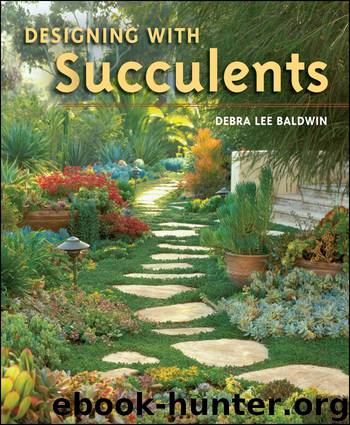Designing with Succulents by Debra Lee Baldwin

Author:Debra Lee Baldwin
Language: eng
Format: epub
Publisher: Timber Press
Published: 2007-01-25T05:00:00+00:00
HARMFUL INSECTS
Just when I have led you to the conclusion that the only answer to keeping your succulents beautiful is to grow them indoors, let me caution you about mealybugs and scale. Plants that do not receive good air circulation and that grow in a humid environment are prone to sucking insects. Succulents in the garden also attract aphids or thrips when flowering buds are young and tender.
Mealybugs look like bits of cotton fluff; scale are hard, oval brown bumps; and aphids and thrips are pinhead-sized, soft-bodied insects that chew and destroy new tissue. Mealybugs usually can be spotted in leaf axils, but they sometimes attach themselves to roots. Scale, on the other hand, tends to latch onto stems and the underside of leaves. Plants with a severe mealybug or scale infestation should be destroyed, lest the pests spread to healthy plants. Discard the soil and wash the pot thoroughly before reusing it.
Insecticides can be sprayed on mealybugs, thrips, scale, and other pesky insects, but I simply use rubbing alcohol instead. I keep it handy in a spray bottle, ready to go at the first sign of a problem. A fine, light spray of alcohol does no damage to succulent leaves and kills the bugs instantly.
Aloes are prone to aloe mite, a microscopic insect that causes tissues near the stem to grow lumpy and distorted. Unfortunately, no cure is known, and affected plants or portions thereof must be removed and destroyed to prevent infestation of neighboring plants. Any tools that may have touched diseased tissue must be cleaned and disinfected.
If your succulents are damaged by rot, you can try to salvage the plant by cutting out the damaged area and replanting the healthy tissue. During a record wet winter in my garden, the roots of a handsome clump of Aeonium ‘Sunburst’ succumbed to rot. At first, the tops of the plants seemed fine, but the florets gradually shrank in size, until what was a lush mini-forest looked wan and spindly. When I pressed the stems, they were firm at the top and soft at the bottom. I pulled the entire clump from the soil, discarded the decayed tissue, and cut the stems to salvage the florets, retaining several firm, healthy inches. The cuttings since have rooted and are thriving.
Download
This site does not store any files on its server. We only index and link to content provided by other sites. Please contact the content providers to delete copyright contents if any and email us, we'll remove relevant links or contents immediately.
Turbulence by E. J. Noyes(7942)
The Thirst by Nesbo Jo(6832)
Gerald's Game by Stephen King(4584)
Be in a Treehouse by Pete Nelson(3953)
Marijuana Grower's Handbook by Ed Rosenthal(3623)
The Sprouting Book by Ann Wigmore(3544)
The Red Files by Lee Winter(3368)
The Remains of the Day by Kazuo Ishiguro(3295)
Sharp Objects: A Novel by Gillian Flynn(2958)
Christian (The Protectors Book 1) by L. Ann Marie(2655)
Organic Mushroom Farming and Mycoremediation by Tradd Cotter(2631)
The Culinary Herbal by Susan Belsinger(2433)
Stone Building by Kevin Gardner(2353)
The Starter Garden Handbook by Alice Mary Alvrez(2285)
Lilac Girls by Martha Hall Kelly(2258)
The Unlikely Pilgrimage of Harold Fry by Rachel Joyce(2221)
The Lean Farm Guide to Growing Vegetables: More In-Depth Lean Techniques for Efficient Organic Production by Ben Hartman(2099)
Urban Farming by Thomas Fox(2062)
Backyard Woodland by Josh VanBrakle(1895)
